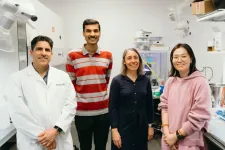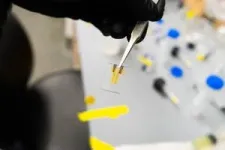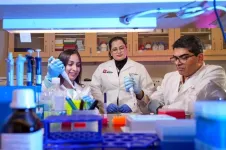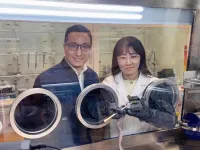(Press-News.org) In a breakthrough that could transform bioelectronic sensing, an interdisciplinary team of researchers at Rice University has developed a new method to dramatically enhance the sensitivity of enzymatic and microbial fuel cells using organic electrochemical transistors (OECTs). The research was recently published in the journal Device.
The innovative approach amplifies electrical signals by three orders of magnitude and improves signal-to-noise ratios, potentially enabling the next generation of highly sensitive, low-power biosensors for health and environmental monitoring.
“We have demonstrated a simple yet powerful technique to amplify weak bioelectronic signals using OECTs, overcoming previous challenges in integrating fuel cells with electrochemical sensors,” said corresponding author Rafael Verduzco, professor of chemical and biomolecular engineering and materials science and nanoengineering. “This method opens the door to more versatile and efficient biosensors that could be applied in medicine, environmental monitoring and even wearable technology.”
Traditional biosensors rely on direct interactions between target biomolecules and the sensor device, which can pose limitations when the electrolyte environment is incompatible. This research circumvents that challenge by electronically coupling fuel cells with OECTs instead of introducing biomolecules directly into the sensor.
“One of the biggest hurdles in bioelectronic sensing has been designing systems that work in different chemical environments without compromising performance,” said corresponding author Caroline Ajo-Franklin, professor of biosciences, director of the Rice Synthetic Biology Institute and Cancer Prevention and Research Institute of Texas Scholar. “By keeping the OECT and fuel cell separate, we ensured optimal conditions for both components while still achieving powerful signal amplification.”
OECTs are thin-film transistors that operate in aqueous environments and have gained attention for their high sensitivity and low-voltage operation. For the study, the team integrated OECTs with two types of biofuel cells to enhance their performance. The first type, enzymatic fuel cells, utilize glucose dehydrogenase to catalyze glucose oxidation, generating electricity in the process. The second type, microbial fuel cells, rely on electroactive bacteria to metabolize organic substrates and produce current. The OECTs were then coupled with the fuel cells in two different configurations: a cathode-gate configuration and an anode-gate configuration.
The researchers found that OECTs can amplify signals from enzymatic and microbial fuel cells by factors ranging from 1,000 to 7,000 depending on the configuration and fuel cell type. This amplification is significantly higher than traditional electrochemical amplification techniques, which typically achieve signal enhancements in the range of 10 to 100 times stronger.
The team discovered that the cathode-gate configuration provided the best amplification, especially when using a specific polymer as the channel material. The anode-gate configuration also showed strong amplification but posed potential challenges at higher fuel cell currents, leading to irreversible degradation in some cases.
Along with boosting signal strength, the researchers found that OECTs also reduced background noise, making measurements more precise. Traditional sensors can struggle with interference and weak signals, but the OECTs produced clearer, more reliable data.
“We observed that even tiny electrochemical changes in the fuel cell were translated into large, easily detectable electrical signals through the OECT,” said Ravindra Saxena, co-first author of the study and graduate student in the applied physics program at Rice’s Smalley-Curl Institute. “This means that we can detect biomolecules and contaminants with much greater sensitivity than before.”
The real-world applications for this technology are vast, and the research team successfully demonstrated a miniaturized version of the system on a single glass slide, proving that the technique is scalable and can be used in portable biosensors.
One of the most promising applications is arsenite detection — a critical need in water safety. The team engineered E. coli bacteria with an arsenite-responsive extracellular electron transfer pathway, enabling them to detect the presence of arsenite at concentrations as low as 0.1 micromoles per liter with a clear, measurable response from the OECT-amplified signal.
Beyond environmental applications, the system could revolutionize wearable health monitoring, where power-efficient and highly sensitive biosensors are in high demand. For example, lactate sensing in sweat, which is an indicator of muscle fatigue, was successfully demonstrated using microbial fuel cells.
“Athletes, medical patients and even soldiers could benefit from real-time metabolic monitoring without the need for complex, high-power electronics,” said co-first author Xu Zhang, a postdoctoral fellow in the Department of Biosciences.
The researchers emphasized that understanding the power dynamics between OECTs and fuel cells is key to optimizing sensor performance, and they identified two distinct operational modes. In the power-mismatched mode, the fuel cell generates less power than the OECT requires, leading to higher sensitivity but operating closer to short-circuit conditions. In contrast, the power-matched mode occurs when the fuel cell produces sufficient power to drive the OECT, resulting in more stable and accurate readings.
“By fine-tuning these interactions, we can design sensors tailored for different applications, from highly sensitive medical diagnostics to robust environmental monitors,” Verduzco said. “We believe this approach will change how we think about bioelectronic sensing. It’s a simple, effective and scalable solution.”
This research was sponsored by the Army Research Office, the Cancer Prevention and Research Institute of Texas and the National Science Foundation.
END
New method developed to dramatically enhance bioelectronic sensors
Rice breakthrough has applications in medicine, environmental monitoring and wearable tech
2025-02-26
ELSE PRESS RELEASES FROM THIS DATE:
Researchers identify potential link between retinal changes, Alzheimer’s disease
2025-02-26
INDIANAPOLIS- A team of scientists at the Indiana University School of Medicine has identified that an eye condition affecting the retina, the light-sensing tissue in the back of the eye, may serve as an early indicator for Alzheimer's disease. Their findings, published in Alzheimer's & Dementia, offer new insights into the potential use of retinal changes as early biomarkers for Alzheimer's, which could improve diagnosis and treatment of neurodegenerative disease.
The research was led by IU School of Medicine PhD Student Surabhi D. Abhyankar, MS, alongside colleagues from the school's departments of ophthalmology and biochemistry and molecular biology, the ...
Hidden allies
2025-02-26
Endophytes: A plant’s friends or foes
Endophytes are microorganisms that live inside plants. Some of these organisms, mostly bacteria or fungi, make the plants sick, while others have no harmful effect on the plants or are even beneficial. Previous studies of endophytic fungi living inside certain grasses have shown that these fungi provide the grasses with a defense against predators. However, little has been known about whether this is also true for trees. The current study investigated the influence of an endophytic fungus of the genus Cladosporium on the herbivore defense of the black poplar Populus nigra, as well as the effects on the insect communities that live on poplars.
"We ...
HKUST unveils critical nanoscale phenomena for more efficient and stable perovskite solar cells
2025-02-26
In a significant advancement for boosting renewable energy generation development, the School of Engineering of the Hong Kong University of Science and Technology (HKUST) has taken the lead in breaking through studies of the nanoscale properties of perovskite solar cells (PSCs). This initiative has resulted in the development of more efficient and durable cells, poised to substantially diminish costs and broaden applications, thereby connecting scientific research with the needs of the business community.
Compared to conventional silicon solar ...
MD Anderson Research Highlights for February 26, 2025
2025-02-26
HOUSTON ― The University of Texas MD Anderson Cancer Center’s Research Highlights showcases the latest breakthroughs in cancer care, research and prevention. These advances are made possible through seamless collaboration between MD Anderson’s world-leading clinicians and scientists, bringing discoveries from the lab to the clinic and back.
Study identifies biomarkers for predicting treatment response in metastatic breast cancer
Standard treatment for patients with hormone receptor (HR)-positive, HER2-negative (HR+/HER2-) ...
Social media posts about medical tests with potential for overdiagnosis
2025-02-26
About The Study: In this cross-sectional study of social media posts about 5 popular medical tests, most posts were misleading or failed to mention important harms, including overdiagnosis or overuse. These data demonstrate a need for stronger regulation of misleading medical information on social media.
Corresponding Author: To contact the corresponding author, Brooke Nickel, PhD, email brooke.nickel@sydney.edu.au.
To access the embargoed study: Visit our For The Media website at this link https://media.jamanetwork.com/
(doi:10.1001/jamanetworkopen.2024.61940)
Editor’s Note: Please see the article for additional information, including other ...
Consumer confidence in the responsible use of digital health data after the COVID-19 pandemic
2025-02-26
About The Study: In this study, confidence in organizations to use health data responsibly was largely unchanged from 2020 to 2022, but polarization increased between politically liberal and conservative respondents. Compared with 2020, in 2022 liberal respondents reported increased confidence in the federal government to use digital health data responsibly, while conservative respondents reported decreased confidence in the federal government and agencies. Changes in confidence may be related to the prominence of these agencies (CDC, NIH) during the COVID-19 pandemic, a 2020 national election with a change in the governing ...
Influencers promoting ‘overwhelmingly’ misleading information about medical tests on social media
2025-02-26
Influencers are promoting “overwhelmingly” misleading information about medical tests on Instagram and TikTok, according to a global University of Sydney-led study published today in JAMA Network Open.
Researchers analysed almost 1000 posts about five controversial medical screening tests that had been promoted by social media influencers to almost 200 million followers. They found most posts had no reference to scientific evidence, were promotional, had explicit financial interests and failed to mention potential harms.
The ...
Two papers by Walhout lab in Nature highlight novel metabolic principles
2025-02-26
Two papers published today in the journal Nature describe a significant advance in understanding the complex functions of the metabolic network. The research is from the lab of Marian Walhout, PhD, the Maroun Semaan Chair in Biomedical Research and chair and professor of systems biology, which has been engaged with fundamental questions of metabolism for more than a decade.
According to Dr. Walhout, organisms constantly monitor their nutrient intake and adjust their metabolism to generate biomass and energy; their ...
Multiplexing entanglement in a quantum network
2025-02-26
Laying the groundwork for quantum communication systems of the future, engineers at Caltech have demonstrated the successful operation of a quantum network of two nodes, each containing multiple quantum bits, or qubits—the fundamental information-storing building blocks of quantum computers.
To achieve this, the researchers developed a new protocol for distributing quantum information in a parallel manner, effectively creating multiple channels for sending data, or multiplexing. The work was accomplished by embedding ytterbium atoms ...
Bacteria consumed by immune cells become part of the cell
2025-02-26
Immune cells that eat bacteria in the body don’t stash them in specialized compartments as once thought, but turn them into critical nutrients that build proteins, create energy and keep the cells alive, according to a new study from scientists at the University of Colorado Anschutz Medical Campus.
“We are what we eat,” said the study’s co-senior author Angelo D’Alessandro, Ph.D., professor of biochemistry and molecular genetics at the University of Colorado School of Medicine at CU Anschutz. “What we eat changes the composition of us and when immune cells eat bacteria the same thing happens to them.”
The ...
LAST 30 PRESS RELEASES:
Modulating key interaction prevents virus from entering cells
Project explores barriers to NHS career progression facing international medical graduates
Jeonbuk National University researchers explore the impact of different seasonings on the flavor perception of Doenjang soup
Two Keck Medicine of USC Hospitals named Leapfrog Top Teaching Hospitals
World-first discovery uncovers how glioblastoma tumours dodge chemotherapy, potentially opening the door to new treatments
A fatal mix-up: How certain gut bacteria drive multiple sclerosis
New AI tool identifies not just genetic mutations, but the diseases they may cause
Deep-learning model predicts how fruit flies form, cell by cell
Combination pills for high blood pressure may simplify treatment, improve long-term health
Immune system keeps mucosal fungi in check
Neurons within the brain use simple rules to localize genetic messages
Electrodes created using light
Second-hand gift-giving is a well-deliberated decision
How human interaction drove evolution to make bears less aggressive
National Poll: Few parents offer teens guidance on healthy eating during holiday season
Cannabis derivatives could provide new ovarian cancer treatments
Raising strong yeast as a petroleum substitute
Clues to the origin of hot Jupiters hidden in their orbits
Canada’s reduced pledge to Global Fund will impact domestic health
1 in 4 children with major traumatic injuries not cared for in pediatric trauma centres
Duke and Duke-NUS’ joint cross-population research to uncover "East-West" differences in disease and care
Scientists to ‘spy’ on cancer- immune cell interactions using quantum technology breakthrough
Tech savvy users have most digital concerns
Making lighter work of calculating fluid and heat flow
Normalizing blood sugar can halve heart attack risk
Lowering blood sugar cuts heart attack risk in people with prediabetes
Study links genetic variants to risk of blinding eye disease in premature infants
Non-opioid ‘pain sponge’ therapy halts cartilage degeneration and relieves chronic pain
AI can pick up cultural values by mimicking how kids learn
China’s ecological redlines offer fast track to 30 x 30 global conservation goal
[Press-News.org] New method developed to dramatically enhance bioelectronic sensorsRice breakthrough has applications in medicine, environmental monitoring and wearable tech






